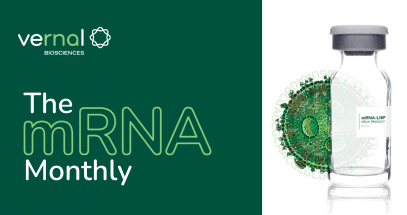
Research‑Grade mRNA That Moves as Fast as Your Ideas
Messenger RNA (mRNA) has become a workhorse of vaccine and therapeutic discovery, but its pace is unforgiving. Project teams now need dozens of constructs, with different sequences, cap analogs, nucleoside mixes, and/or UTR, delivered in weeks, not months. They also need those mRNAs to meet increasingly stringent quality demands. However, when sourcing research-grade mRNA, it…

Expert Analytics Drive Successful mRNA Therapeutic Development Programs
Messenger RNA has redefined what rapid looks like in drug development. Yet the very flexibility that makes mRNA attractive also makes it unforgiving—minute variations in purity, structure, or LNP encapsulation can eliminate potency or introduce safety risks. It’s never too soon to start designing a characterization and quality strategy because analytics cannot be an afterthought. Instead, they…

Awakening the Giant: The Next Frontier in mRNA Therapeutics
The remarkable success of messenger RNA-based vaccines during the COVID-19 pandemic has sparked widespread interest and enthusiasm around mRNA technology. But vaccines are just the beginning. Researchers and biotech innovators worldwide are rapidly uncovering the broader potential of mRNA to address a vast array of health challenges, from cancer and genetic diseases to regenerative and…

The Evolving Needs of Therapeutic mRNA Developers
Given the strides medical researchers and therapeutic developers were making, the possibility of commercializing mRNA therapeutics began looking bright about ten to fifteen years ago. However, one of the most pressing issues restricting researchers’ efforts was the lack of a reliable high-purity mRNA supply. There weren’t players that could readily and reliably provide end-to-end mRNA…

Leveraging mRNA to Revolutionize Antibody Manufacturing
How an mRNA-encoded antibody platform could accelerate therapies to clinic Therapeutic antibody production is traditionally complex and costly, which drives up treatment prices. However, encoding antibodies with mRNA offers a potential solution to many of these challenges, making the process more cost-effective and faster to reach clinical use. Recent data showing preclinical feasibility suggests that…

The mRNA Monthly—November 2024 Newsletter
mRNA for Antibody Manufacturing In collaboration, Charles River Lab and Vernal Biosciences released this scientific poster. Since its release, new advancements have been made and new data is available to share. Join the webinar on December 12 to dive into this new data and hear from the researchers directly. GET REGISTERED Clinical Trial: mRNA COVID-19…
